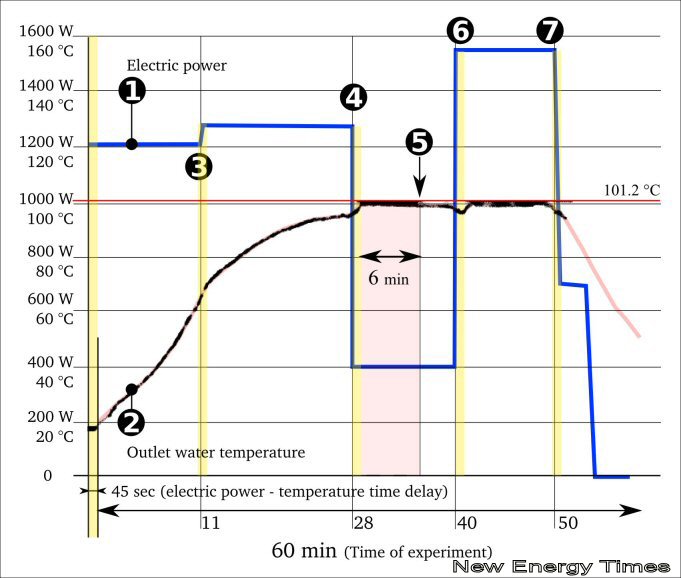|
⇐ Previous Article — Table of Contents — Next Article ⇒
New Energy Times home page
Anonymous* Mechanical Engineer's Analysis of Power and Temperature in Jan. 14, 2011, Rossi Experiment
Appendix 17 to New Energy Times Report #3

This is a graph of the electrical power input and temperature output measured in the vertical pipe of the Rossi device versus time for the Jan. 14, 2011 demonstration. This experiment was performed by Andrea Rossi, Giuseppe Levi and several other professors from the University of Bologna. Rossi and Levi have never presented an integrated graph of the electrical energy input and the temperature output. According to them, the data were lost.
It is not possible to state that the temperature measurements were of steam or of water. All we know is where the temperature measurements were made. The reasons for this are a) the Rossi group did not present data for pressure measurements in the vertical pipe or state that the pressure was continuously monitored, b) optical inspection inside the vertical pipe was not possible, and c) thermodynamic conditions, as explained in other analyses in Report #3, suggest that water filled the vertical pipe above the level at which this temperature sensor was placed. It is therefore inappropriate to call the vertical pipe a "chimney," as Rossi has suggested.
Here is a step-by-step analysis of what we can see from the facts.
(1) The applied power is initially 1,200 watts. The source for the electrical power input data comes from the graph in Levi's Jan. 21, 2011, report.
(2) The temperature is initially about 20°C. The source for the temperature data comes from a video screen image presented to the public from that experiment.
(3) At this point, there is an increase of just 70 watts of power, but at the same time, the rate of temperature increase slows down.
A hypothesis that explains this anomalous change in the slope of the temperature ramp is possible. Consider that, at the beginning of the experiment, Rossi may have stopped the water flow. Recall what Celani wrote in his report: “The experiment, at the beginning, didn’t start properly because the main heater had a catastrophic failure." In the beginning, the apparatus must be heated, and starting the heating apparatus without water flow may be an effective procedure. Then, when the water temperature reaches 60°C, the water flow can be started.
However, this procedure may apply only to the January 14, 2011, experiment. Rossi's other experiments indicate no evidence of this change in the slope of the temperature ramp.
(4) Rossi reduces the power to 400 watts. There are no feedback or control sensors in the experiment; the heaters are controlled manually with switches used to dim lights. For the next six minutes, the temperature stays at 101.2°C.
(5) The temperature begins to drop at the end of possibly some kind of abnormal phenomenon.
(6) Rossi makes a sharp increase in the applied power, up to 1,550 watts. The temperature goes back up to 101.2°C.
(7) The sequence does not provide unambiguous results, and after 50 minutes, the experiment is stopped.
Therefore, it is possible to identify two periods of operation:
1. Operation with probable excess-heat emission during the period between points (4) and (6). Observing this diagram reveals that the experiment has probably been successful, with a possible excess-heat effect of 200% to 300% only in the first six minutes after reaching the boiling temperature of 101.2°C.
2. Operation without any abnormal emission energy (5)-(7). During this period, Rossi has disproportionately increased the electric power (1,550 Watts). In this period, it is unlikely that the system is producing excess heat because the reduction in power at (7) does not show a gradual reduction of temperature. There is an immediate reduction in temperature, which confirms that, at this stage, the device is producing only electrical heating.
* Author Information (Italy)
The author of this report has a degree in mechanical engineering. He works as a computer consultant, specifically as an advanced technology adviser, particularly in the renewable-energy sector. He has asked to remain anonymous. We agreed because we have confirmed his identity, we consider his information useful, and Rossi has recently publicly threatened and attempted to intimidate several qualified critics.
⇐ Previous Article — Table of Contents — Next Article ⇒
| 
